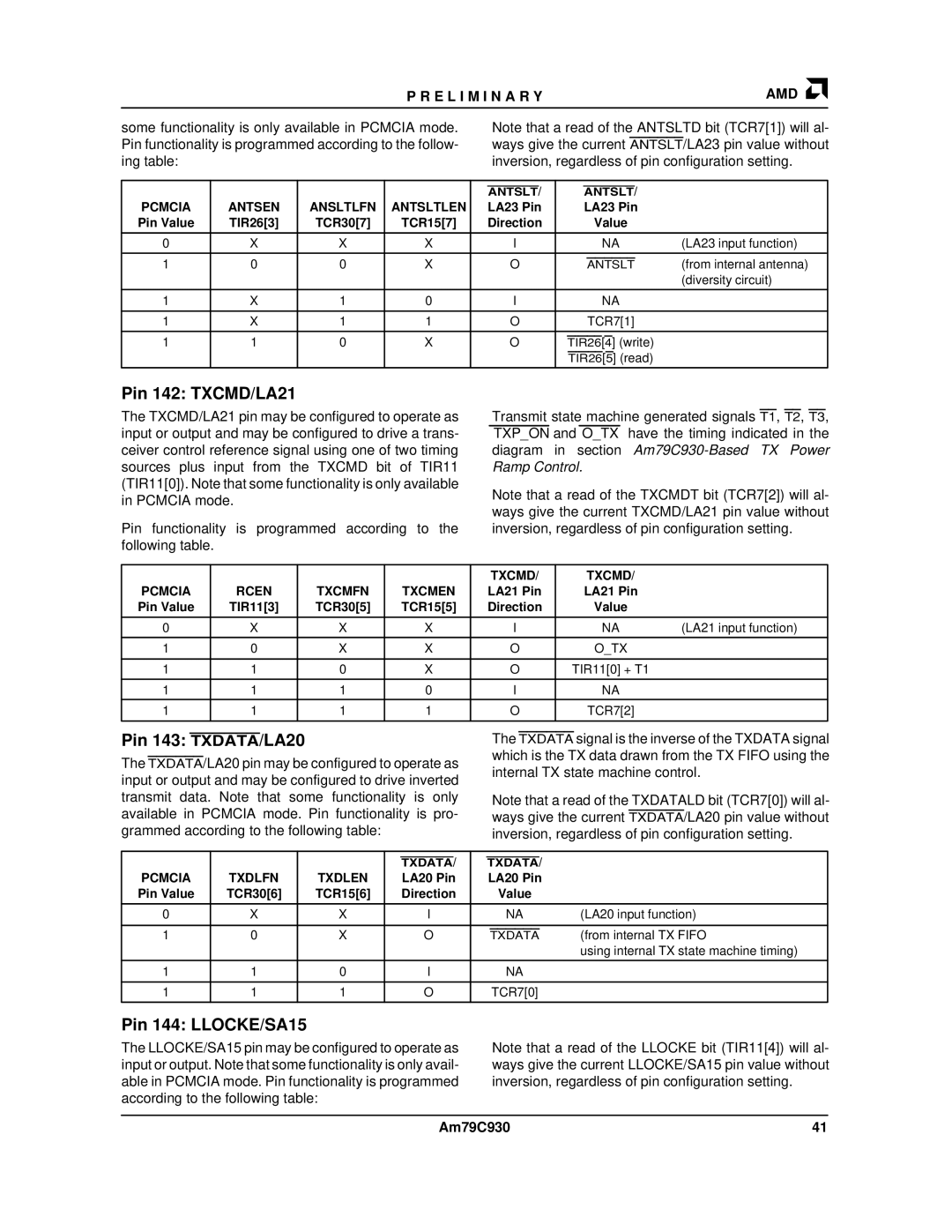
P R E L I M I N A R Y | AMD |
|
|
some functionality is only available in PCMCIA mode. Pin functionality is programmed according to the follow- ing table:
Note that a read of the ANTSLTD bit (TCR7[1]) will al- ways give the current ANTSLT/LA23 pin value without inversion, regardless of pin configuration setting.
|
|
|
| ANTSLT/ | ANTSLT/ |
|
PCMCIA | ANTSEN | ANSLTLFN | ANTSLTLEN | LA23 Pin | LA23 Pin |
|
Pin Value | TIR26[3] | TCR30[7] | TCR15[7] | Direction | Value |
|
|
|
|
|
|
|
|
0 | X | X | X | I | NA | (LA23 input function) |
1 | 0 | 0 | X | O | ANTSLT | (from internal antenna) |
|
|
|
|
|
| (diversity circuit) |
|
|
|
|
|
|
|
1 | X | 1 | 0 | I | NA |
|
|
|
|
|
|
|
|
1 | X | 1 | 1 | O | TCR7[1] |
|
1 | 1 | 0 | X | O | TIR26[4] (write) |
|
|
|
|
|
| TIR26[5] (read) |
|
|
|
|
|
|
|
|
Pin 142: TXCMD/LA21
The TXCMD/LA21 pin may be configured to operate as input or output and may be configured to drive a trans- ceiver control reference signal using one of two timing sources plus input from the TXCMD bit of TIR11 (TIR11[0]). Note that some functionality is only available in PCMCIA mode.
Pin functionality is programmed according to the following table.
Transmit state machine generated signals T1, T2, T3, TXP_ON and O_TX have the timing indicated in the diagram in section
Note that a read of the TXCMDT bit (TCR7[2]) will al- ways give the current TXCMD/LA21 pin value without inversion, regardless of pin configuration setting.
|
|
|
| TXCMD/ | TXCMD/ |
|
PCMCIA | RCEN | TXCMFN | TXCMEN | LA21 Pin | LA21 Pin |
|
Pin Value | TIR11[3] | TCR30[5] | TCR15[5] | Direction | Value |
|
|
|
|
|
|
|
|
0 | X | X | X | I | NA | (LA21 input function) |
|
|
|
|
|
|
|
1 | 0 | X | X | O | O_TX |
|
|
|
|
|
|
|
|
1 | 1 | 0 | X | O | TIR11[0] + T1 |
|
|
|
|
|
|
|
|
1 | 1 | 1 | 0 | I | NA |
|
|
|
|
|
|
|
|
1 | 1 | 1 | 1 | O | TCR7[2] |
|
|
|
|
|
|
|
|
Pin 143: TXDATA/LA20
The TXDATA/LA20 pin may be configured to operate as input or output and may be configured to drive inverted transmit data. Note that some functionality is only available in PCMCIA mode. Pin functionality is pro- grammed according to the following table:
The TXDATA signal is the inverse of the TXDATA signal which is the TX data drawn from the TX FIFO using the internal TX state machine control.
Note that a read of the TXDATALD bit (TCR7[0]) will al- ways give the current TXDATA/LA20 pin value without inversion, regardless of pin configuration setting.
|
|
| TXDATA/ | TXDATA/ |
|
PCMCIA | TXDLFN | TXDLEN | LA20 Pin | LA20 Pin |
|
Pin Value | TCR30[6] | TCR15[6] | Direction | Value |
|
|
|
|
|
|
|
0 | X | X | I | NA | (LA20 input function) |
|
|
|
|
|
|
1 | 0 | X | O | TXDATA | (from internal TX FIFO |
|
|
|
|
| using internal TX state machine timing) |
|
|
|
|
|
|
1 | 1 | 0 | I | NA |
|
|
|
|
|
|
|
1 | 1 | 1 | O | TCR7[0] |
|
Pin 144: LLOCKE/SA15
The LLOCKE/SA15 pin may be configured to operate as input or output. Note that some functionality is only avail- able in PCMCIA mode. Pin functionality is programmed according to the following table:
Note that a read of the LLOCKE bit (TIR11[4]) will al- ways give the current LLOCKE/SA15 pin value without inversion, regardless of pin configuration setting.
Am79C930 | 41 |
